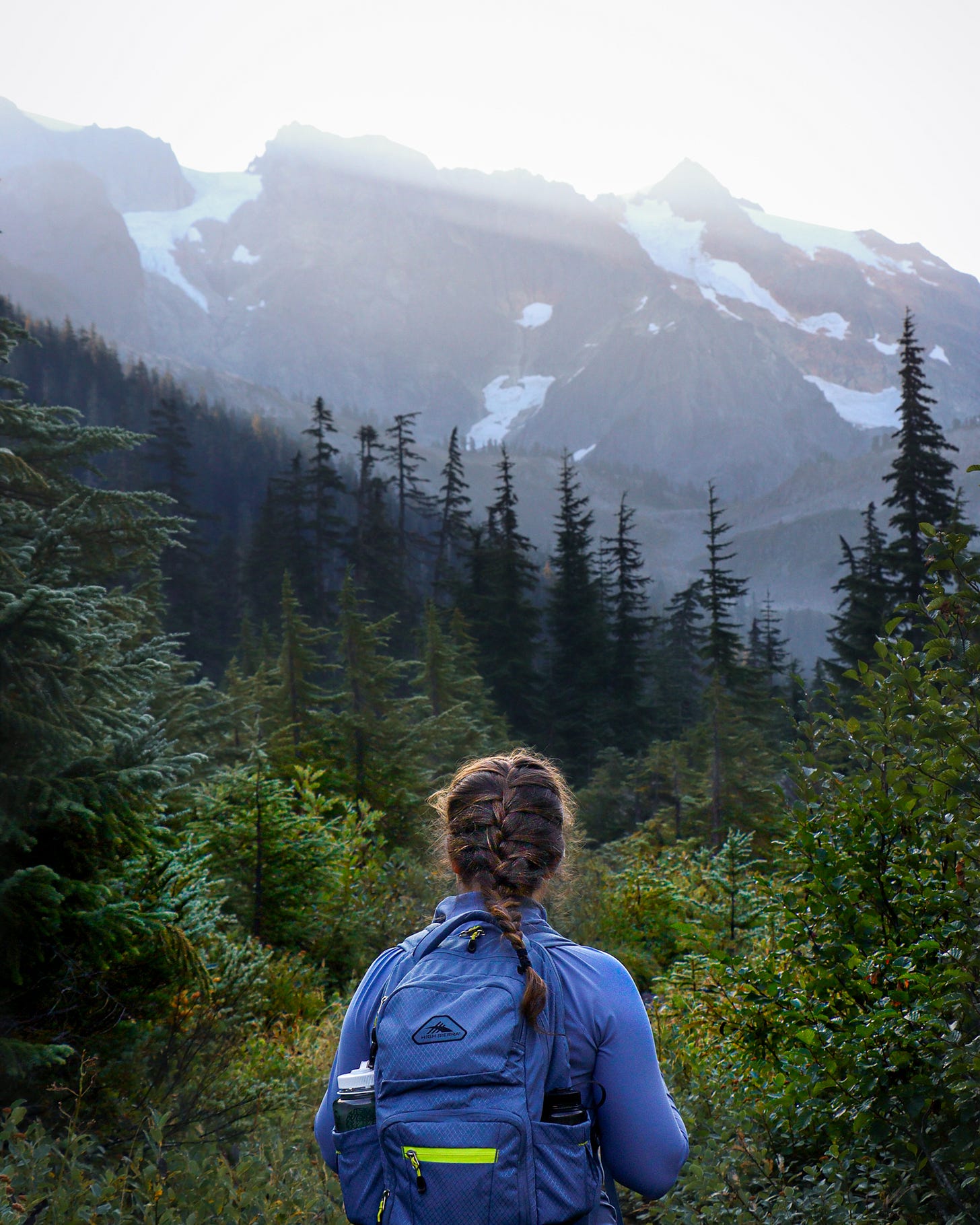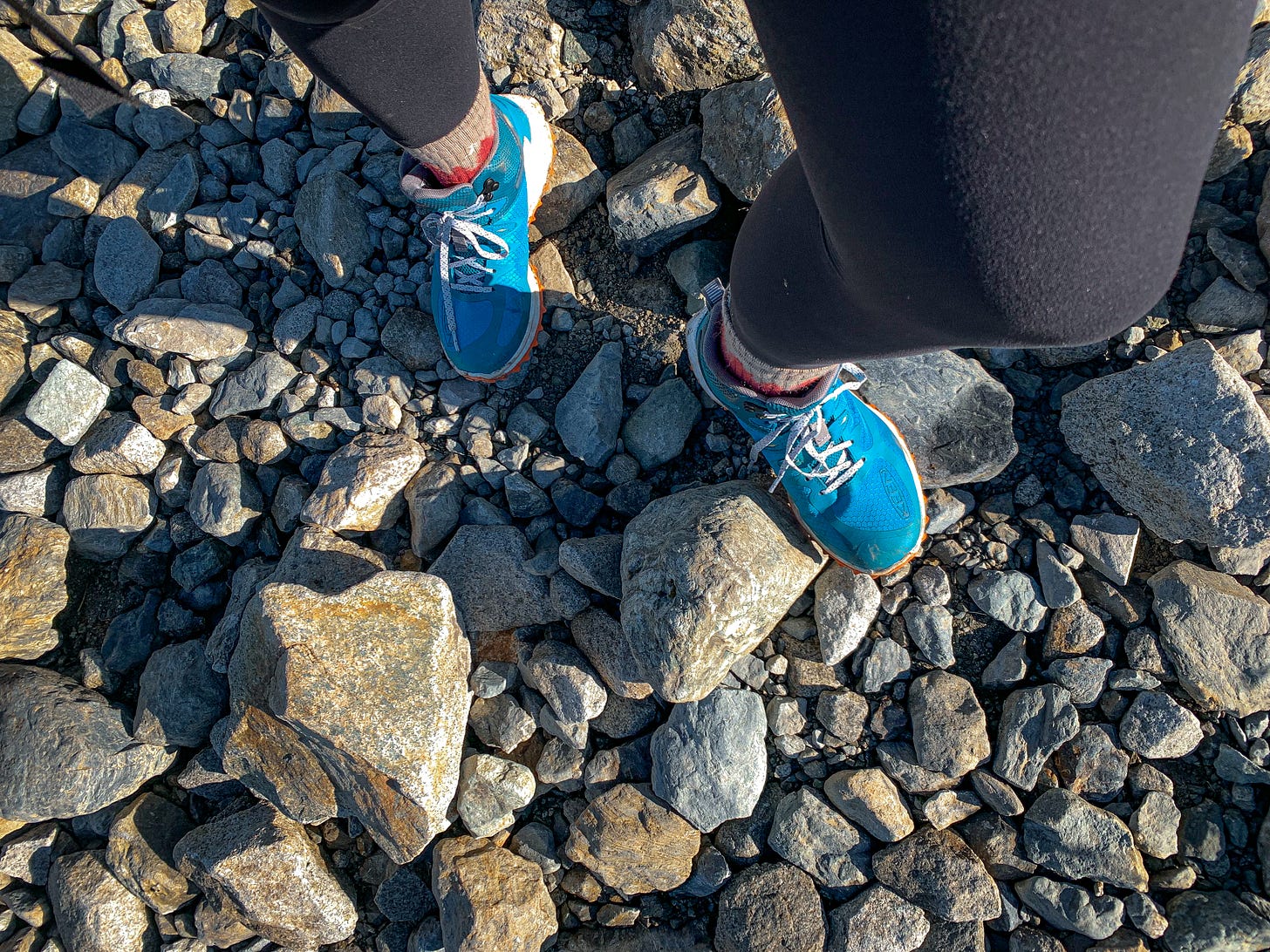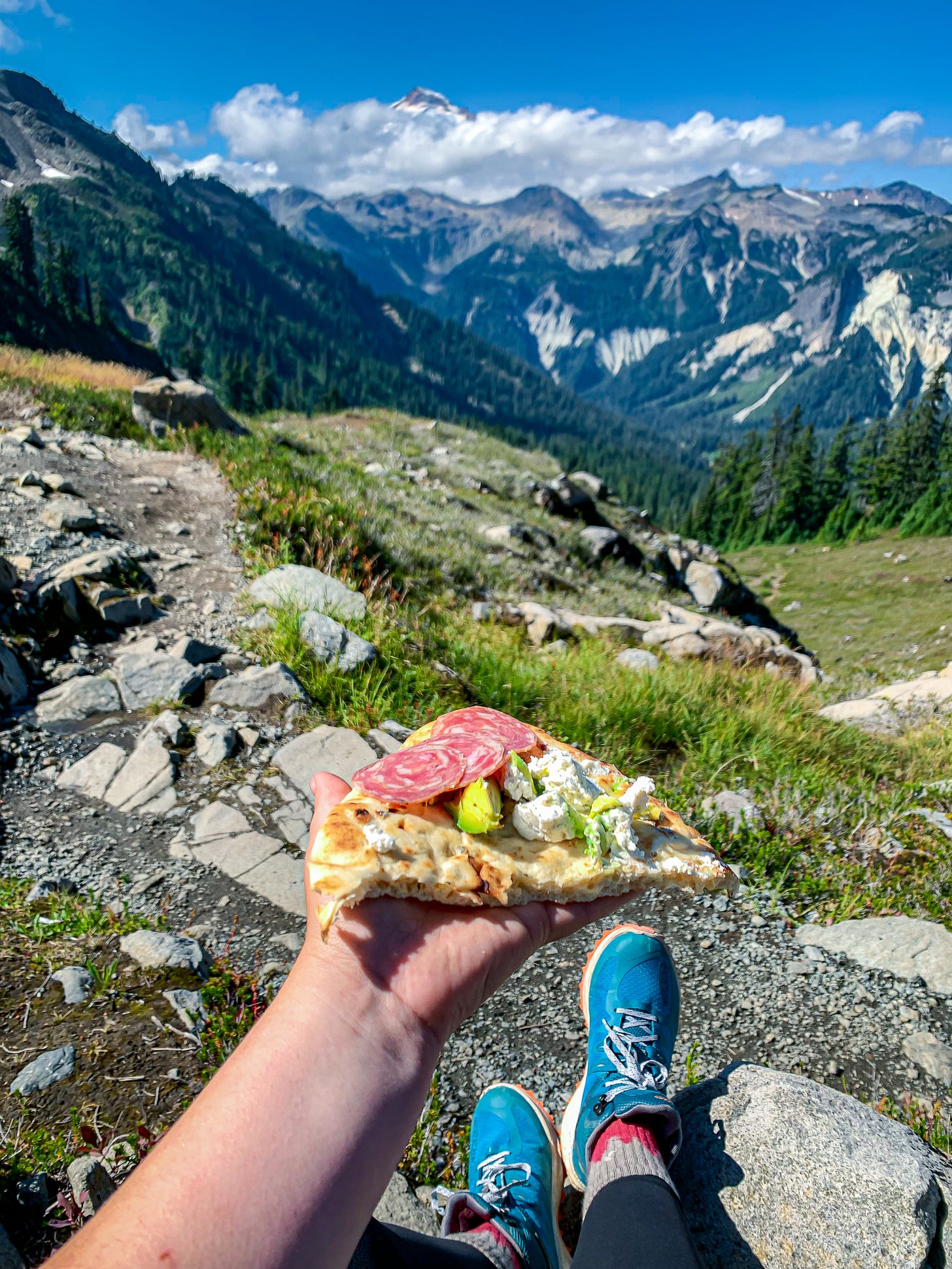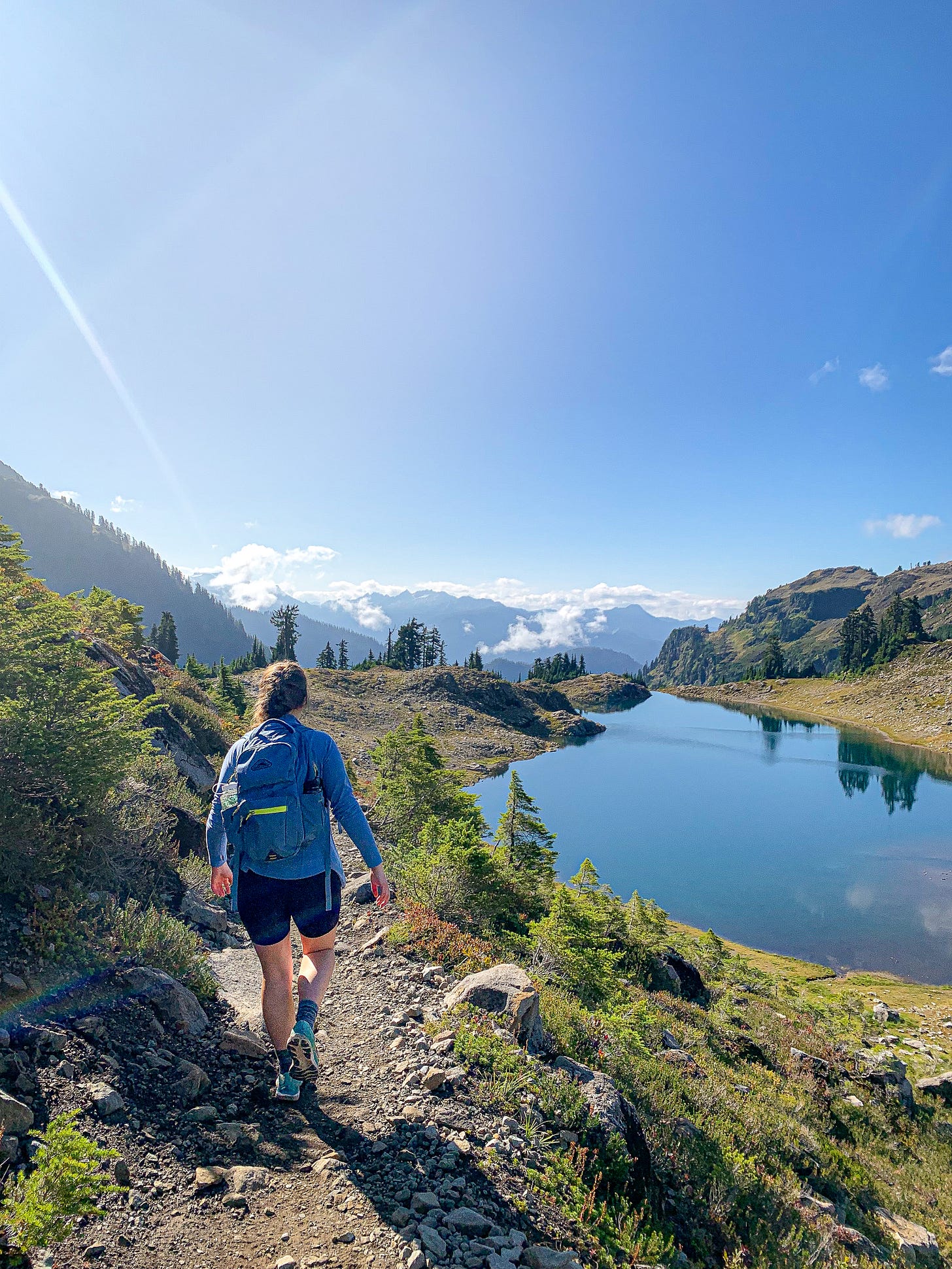If I’m ranking the best trails I’ve ever hiked, Lake Ann would easily be top three. The backpacking route I did in Armenia, the Rose Lake Cliffs and Caribou Rock Trail in Northern Minnesota in the Fall, and the Lake Ann Trail in the North Cascades, but in no particular order.
I work as an overnight sea kayaking guide in the summer—the constant work in the outdoors means aside from work trips, I don’t get out much in the summer. But the summer is slowly winding down. The first red leaves have hit the ground, and the air is cooler earlier, and it’s dark before eight again.
In Friday Harbor the streets are empty on non-weekend days. I’ve got free time again, and there is nothing quite like late season travel.
I’ve got a lot of late-season travel penciled in for September. Soon I’ll be going on an overnight paddle that’s actually not for work out to some of the outer islands in the San Juans. I’ll be back in Minnesota for a few days at the end of the month. And this past week, my sister came from Michigan to spend the week travelling Washington with me.
I wanted to show her the mountains. Also, I had never really been to the mountains in Washington— I was starting to believe they were a myth.
All that I knew of Washington was the highway across the state and the San Juan Islands. I wanted to see what the hype was about.
Lake Ann Trail Review: 10ish miles, 2,150 elevation gain. Mount Baker-Snoqualmie National Forest
I’d put a lot of thought about where to hike what with wildfires in the North Cascades— while Andy and I were in Olympic National Park at the end of the month, I sat down to research and saw there was one available campsite left to reserve in one of the car camping spots near Mount Baker. Sites like that go fast, especially on a weekend, so I booked it.
Only sort of related, the apartment Andy and I are renting for the winter is pretty close to this section of the North Cascades— I wanted a chance to both check out the apartment itself before we move in at the end of the month, and to get a better handle on what the nearby trail situation is like.
To get a good parking spot at most of the best trailheads, you want to be on the trail pretty early or start later in the day. It helps to be camped nearby. After booking sites, I scouted out potential nearby trails in the area and eventually settled on the Lake Ann Trail.
We hit the trail at 6:30 and were likely the first day hikers out that morning. The hike itself is beautiful— glacier views, Mount Baker, alpine streams and beautiful Lake Ann. One of the backpacker groups saw a bear up at the saddle, but either it had moved on by the time we made it there or we scared it off with our chatter.
We tried to hike the entire way to the Lower Curtis Glacier— the map made it look like there was some sort of non-mountaineering hiking trail that could get you all the way there— but we decided at like the 20th switchback that it was a little sketchy for your average day hiker (us).
Keen Zionic Hiking Boot Review:
Earlier this month I was sent a pair of the new Keen ultralight hiking boots to review! I wore them out on this 12 + mile hike without breaking them in (aside form a short walk around one of the local San Juan Island trails).
The new Keen Zionics are marketed as waterproof, with a wider toe box for comfort, and designed for speed while hiking.
I got them in a size 6.5, which is usually a pretty perfect fit for me, especially considering my feet swell a lot when hiking. The Keen Zionics were a little large, so I would recommend sizing down.
Despite zero effort to break in these shoes and them being a little loose, I got zero blisters or hot spots on a 12 mile hike. Part of that might be that sea kayak guiding has turned my entire foot into one massive, seawater-laden callous, but I was definitely concerned about blisters at the ankles and on my toes.
The shoes are waterproofed in a way that is perfect for a hike like Lake Ann with small stream crossings that are never deeper than the ankle.
Like most waterproof shoes if you submerge your foot above the ankle water will simply spill in and flood the shoe, and it’s unlikely to dry fast. This may seem obvious, but I’ve found from working in an outdoor retail store that a lot of people don’t understand what waterproofing exactly entails.
In general, one con of waterproof shoes I’ve found is that once your foot is wet, be it from sweat or water seeping in, the waterproof shoe is less breathable. That being said, it wasn’t an issue at all on this hike, and on most dry hikes with minor stream crossings would not be an issue at all. I have yet to test how quickly the inside of the Keen Zionic Hiking Boot dries.
Comfort and waterproofing were awesome, but I’m not sure how I would begin to measure the speed of the boot, the boots alleged selling point.
One thing I will say is that it is much lighter on your foot than a typical hiking boot— they say a pound on your foot is five on your back, and the unique sneaker-like design of the Zionic Hiking Boot keeps it much lighter than a traditional hiking boot while maintaining the ankle support in the high-top model.
While lighter than the traditional hiking boot, I did find the traction to be less than I had hoped for, and slid on rock in a few spots. I would say that the traction is as to be expected for what the product is— essentially an ultralight hiking boot— and would be well suited for most trails without slick, wet rocks or particularly uneven footing.
Compared to my Oboz Bridger Mids:
I really, really love my beefy Oboz Bridger Mids. They are a true hiking boot made for difficult terrain, to provide protection, ankle support, and even a little warmth, and they are the absolute anthesis to the Zionics, an ultralight shoe designed with speed, comfort, and wear and tear on your body in mind, to the point that it even seems silly to compare them.
If you’re tackling a colder weather hike with technical terrain, mud, etc, and like traditional support, the Bridger Mids make sense, but they are overkill on almost everything that is not a technical hike with difficult footing.
The Zionics are great for well-travelled to moderately travelled paths and for backpackers looking to cut weight. Think National Park day hiking, or backpacking the Appalachian Trail for speed.
Price-wise, the Bridger Mids retail at 200 USD, while the Keen Zionics retail at $170.
Compared to Trail Runners:
I’ve got a few pairs of trail runners in various disrepair that are all essentially slightly beefier running shoes. I use them for hiking some of the time, walking around town, or paddling because they tend to dry quickly. They aren’t waterproofed, and provide decent traction.
The Zionics provide comparable traction to the average trail runner, and the Keen Zionic hiking boot (as opposed to the shoe) provides deceptively awesome ankle support despite its lighter weight. If you’re looking for a hiking boot comparable to a trail runner in weight but with the waterproofing and ankle support of a full hiking boot, the Keen Zionic boot is a great choice for you.
Overall Keen Zionics Hiking Boot Review:
In general, I would say the Zionics are a great boot for anyone worried about blisters (I got literally none), or pitching in a boot, anyone looking to do fast miles with a light pack on well to moderately travelled trails over anything but extremely technical terrain.
The Lake Ann Trail at a Glance: difficulty — moderate
At about 12 miles round trip, the Lake Ann Trail including a little extra hike toward the Lower Curtis Glacier clocks in at a moderate hike for hikers in the mid-range of hiking fitness [3-6 mile day hikes or walks 1-2 times a week. Has experience with 10+ mile day hikes, alternately regularly runs 4-6 miles in one go, or comparable outdoor activities].
While I kayak about 12 miles a day almost every day all summer, I did find myself sucking down air and pink-faced both coming up the saddle and on the ascent back into the parking lot. Must be that sea level air. My sister, a runner, fared a little better.
Still, overall the trail itself was not technical and beginner-friendly with the exception of the approach to the Lower Curtis Glacier, and the uphill sections are absolutely manageable for a very motivated hiker with only shorter hike experience.
Note that the downhill sections can be very hard on your knees. I found the most difficult stretch to be the last push to the parking lot, mostly psychologically so. Despite being a full time overnight sea kayaking guide and likely in better shape than most, I did find parts of this hike to be challenging.
It’s of course, worth noting that advanced physical fitness in one discipline (ocean kayaking) doesn’t necessarily translate to the same liege of physical fitness in another discipline (alpine hiking).
Alternate Option: drive up to the Artist’s Point parking lot above the trail and hike some of the shorter trails departing form the parking lot. The views up here are incredible, and there are a few routes that I would consider extremely beginner/mixed-ability friendly.
The views— exceptional
From the second you hit the valley to the slow climb up the saddle, you’re treated to views of Mount Shuskan and Mount Baker, then later Lake Ann and the Lower Curtis Glacier. Truly any direction you look, you’ve got incredible mountain views.
I would say of all of the trails I’ve hiked in my life, this trail had the most consistent incredible views. It’s not often you get a hike where the entire trail is a treat to hike, but Lake Ann is definitely that sort of hike.
The other people — very friendly, moderately trafficked
My sister and I hit the trail before most people. We hiked from 6:30 am till 2pm and by the time we returned to the car the parking lot was completely full (Friday, early September).
We saw plenty of other groups on the trail, but not so many that it felt like hiking through a theme park (we’ve all been on those trails). Everyone was extremely friendly, and it was honestly one of the most positive experiences I’ve had on a trail with regards to other hikers. The great views must’ve put everyone in a great mood, because everyone stopped and chatted with us and joked around about how early we must’ve been on the trail. We shared some of our leftover sausage with a couple in their late 50s with a view of Mount Baker. Altogether excellent experience.
Leave No Trace on the Lake Ann Trail
On the Lake Ann Trail, it’s important to pack out all waste including human waste. Plastic bags are provided for this at the trailhead, but it’s always a good idea to bring your own just in case. Note that digging a cathole is not allowed on this trail; you must pack out your poop.
As always, toilet paper, trash, orange peels, etc, must also always be packed out.
Stay on the primary trail, and avoid trampling fragile plant life by venturing off trail. When encountering a muddy patch of trail, walk directly through the mud to avoid widening the trail on either side (oh hey, a good time for those lightweight waterproof hikers! You can rinse them in the next stream, no worries).
A quick ranking of my 10 favorite hiking trails ever (and links to trailheads/reviews)
Rose Lake Cliffs via CRT in the Fall, BWCA— a long, 14-mile stroll over difficult terrain (like truly difficult, basically rock climbing but slick tree roots) featuring overlooks of lakes below, a waterfall, and eventually the most incredible overlook in Minnesota, with a nearly 270 overlook of Rose Lake winding below you and the Canadian Lakes beyond. This hike is just freaking gorgeous.
Meghri to Kapan, Armenia— In my Peace Corps days, I did a three-day trek through Southern Armenia and through the mountains and it was so beautiful, and so much fun. I haven’t really written much about this trip, and I didn’t really take many pictures, but one day I’ll write more about it. My favorite moment was plucking wild plums off the trail and eating them. My other favorite moment was when a shepherd, the last in the village winterizing, tried to get us to stay with him for the night because it was supposed to snow, and sent us on our way with some apples and quinces. We woke up to snow-capped pink mountains that night. It was really beautiful.
Lake Ann Trail — I don’t know, maybe this one will move farther up once the nostalgia sets in, do you know what I mean? Half of what makes an incredible hike is how it looks a shimmery gold in hindsight, the shared nostalgia with you and the people you shared the moment with.
Mount Baldy, Tettegouche State Park— I hiked this alone in the fall last year, just a quick three mile jaunt but it was beautiful. I snowshoed it in the winter twice, thick trees coated in snow. It’s a beautiful hike with both views of Lake Superior and views of Nicado Lake from above in the fall. Really incredible spot.
Roan Mountain on the AT, Tennessee— I hiked this trail at sunset my senior year of college, two nights in a row. It feels like you’re hiking at the tallest point in the mountains, with Appalachian sprawl on either side of you. I’d like to come back when the rhododendron are in bloom.
Ram’s Head, Virgin Islands National Park— a hike I did on a trip with my family. We saw sea turtles and caucuses and the ocean on all sides and went for a swim on our way back to the car.
The Coves & Spray Falls in the Pictured Rocks National Lakeshore— I’ve done this hike two, three times now? The Coves are the most wonderful backcountry swim spot in the world with some easy cliff jumping and sea caves to explore, and Spray Falls is beautiful as well.
Kadunce River Trail— Only accessible in the dead of winter when frozen or the heat of summer when the river is mostly dry, this canyon is an incredible hike in Northern Minnesota. I think I prefer it in the winter. It’s magical.
Day Hill in Split Rock Lighthouse State Park— Another truly beginner friendly trail, this trail was my favorite spot in the world when I was living in Two Harbors. I don’t know if it really belongs on a “best hiking trails I’ve hiked” list, but it’s definitely one of my favorite spots in the world. I’ve pretty much only solo hiked here, and went almost twice a month. I’d bring a thermos of tea and drink it on top of the hill overlooking the lake and let myself feel the cold on my face. Winters are really hard in Northern Minnesota; hiking that trail reminded me to practice finding them beautiful.
I had trouble thinking of a tenth point because it seemed really final, and also because I’ve done a lot of shorter national park hikes that I don’t feel like count either because I didn’t spend time on the trail, or really engage with it, and I just didn’t feel the connection because it was too “national park theme park” to really feel like my own idea of what a hiking trail should be. In that category were the Hoh Rainforest in Olympic NP and Avalanche Lake in Glacier. I’ve been lucky to live in places with access to beautiful hiking trails and part of my idea of what hiking looks like as developed around the idea of having some semblance of solitude on those trails, which isn’t really the case when it comes to popular national park trails, which is why generally I just completely avoid national parks. Maybe that will change with living out west and having more access to National Parks. In Minnesota my nearest national park was Isle Royale, which is not exactly booming with visitors.











maddy, i love those pics of your sister! the sun-glow around her hair is ethereal.